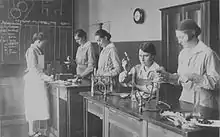
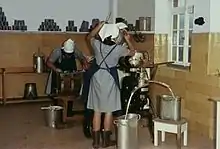
The Reifenstein schools (German: Reifensteiner Schulen) were the various schools of higher education for women associated with the Reifensteiner Verband.
The concept was initiated by Ida von Kortzfleisch, a Prussian noble woman and early German feminist. Reifenstein refers to Reifenstein in Eichsfeld, a municipality in Thuringia and site of the first permanent school. From 1897 to 1990 the Reifensteiner Verband operated about 15 of its own schools and cooperated with further operators. About 40 wirtschaftliche Frauenschulen, rural women's economic schools, were connected to the Reifenstein concept and movement. The association and its journals provided an alumni network and a job placement service, as well as strengthening home economics (Ecotrophology) as an academic discipline and were important for consumer advice and rural social services over all. About 90,000 women took the higher education courses. Some of the alumni, like Käthe Delius, Marie-Elisabeth Lüders and Freya von Moltke had an important role in German higher education and German society overall.
Background
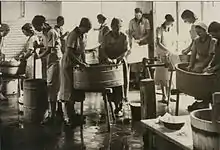
Under the German Empire until the early 20th century, household services played a central role in the employment of women. Instead of a systematic training as in the dual system of vocational education, the education of women in the countryside happened often along a principle of on-the-job training. Young men at this time often gained skills from winter schools and various professional educational institutions. Rural women's education was deemed a troubled sector and its shortcomings were a main topic of the early women's movement.
A 1913 doctorate by Joachim Kramer about the household education in Germany refers to the ongoing reform aspects. The 1870s saw some progress; the first winter schools had been founded by the Badische Frauenverein, founded by Princess Louise of Prussia in the state of Baden.[1] While the winter schools lost their impact to permanent schools in Baden already before World War I, they gained importance in Bavaria in the 1920s. Kramer compared the German situation and the state of household education abroad: Switzerland, Belgium and Austria had winter schools; The Austrian education for rural women was comparably backward, and Switzerland took a leading position. In France, housekeeping was a topic in primary schools, but not part of higher education. According to Kramer, Iowa and the state of New York in the United States were then leading in the field.[2]
The technical equipment and technology available to households gained importance in the 19th century. According to Hans Jürgen Teuteberg, the household literature then started to address women. Earlier works, like the Hausväterliteratur (Hlaford books, a German kind of early economic literature) addressed the pater familias, male and noble heads of larger rural households. Within the second half of the 19th century, women - as house mother or housewives - were being perceived and addressed.[3] The new role of the housewife as head of the household was being deemed a positive development first and only later was "how housewives were being made" deemed negative.[4]
Ida von Kortzfleisch
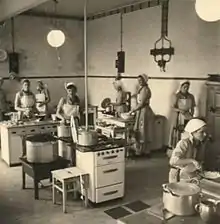
In 1894, Ida von Kortzfleisch published an article in Tägliche Rundschau, a Berlin newspaper, called The Female compulsory service in the economist college for women. She responded to a series of articles by the writer Otto Leixner about the "Female Question" in Germany. Leixner had loathed the women's rights movement (as Weiberrechtlerinnen) and he had deplored their alleged lack of patriotism. Kortzfleisch asked to establish a female service year, similar to the Einjährige, a year of military service of male graduates of high schools. Ida von Kortzfleisch explicitly associated her efforts with women's rights as a citizen in the Kaiserreich.[5] The controversy distributed to establish higher education for women in the wirtschaftliche Frauenschule.
Development
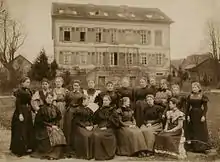
The first classes started in Ofleiden, but was transferred to Reifenstein soon after. The states of Prussia provided an official acknowledgement in 1909.[6] In 1913, the Reifenstein association was admitted to the Bund Deutscher Frauenvereine. The conservative and basically-Protestant background did not hinder a cooperation with the Jüdische Frauenbund (Jewish Women's Association), which established a Jewish Reifenstein school in Wolfratshausen in 1926.
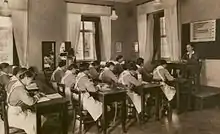
The Reifenstein association and its schools was included in the Reichsnährstand in 1934. The noble background of various pupils and the close connection to the Protestant church lead to some clashes with the regime.
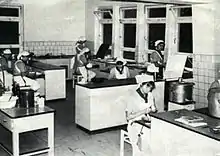
Bad Weilbach, Chattenbühl, Obernkirchen, Wittgenstein and Wöltingerode reopened 1946 in the western occupation zones. The eastern parts went into state ownership in 1947. Some of the schools in the far Eastern part of Prussia, e.g. the Landfrauenschule Metgethen had been destroyed during the end of war. The 1960s saw major changes in the concept, e.g. the end of the compulsory maiden costume. The first male student was admitted in 1980. The last two schools closed down in the 1990s and are now part of a Protestant youth organization.
Trivia
Marie-Elisabeth Lüders reported about mocking remarks from Berlin friends about the rural sites and backgrounds of the schools. Carry Brachvogel provided material for improved household knowledge in Bavaria. She deplored the lack of quality cuisine in the Free State of Bavaria and expected some improvements via the training courses provided by teachers trained in Reifenstein schools.[7] The Bayerische Kochbuch (Bavarian Cookbook), a still-famous household item, is not about specific Bavarian menus, but is based on the experience of the school in Miesbach.[7]
Famous pupils
- Elisabeth von Barsewisch and Gisa von Barsewisch, authors[8]
- Caroline Hermine and Henriette, daughters of German Emperor Wilhelm II, in Obernkirchen
- Käthe Delius, (1893–1977), longtime head of Bundesforschungsanstalt für Hauswirtschaft, the federal research institute for household economics
- Friederike Luise von Hannover, later Queen of Greece, 1937 in Obernkirchen
- Marie-Elisabeth Lüders 1899 in Nieder-Ofleiden, German feminist and politician
- Freya von Moltke, member of the 20 July movement
- Ruth von Kalkreuth, pioneer of the Landfrauenmovement in Württemberg[9]
- Elisabeth von Thadden, educator and member of the 20 July resistance movement
- Ernestine von Trott zu Solz, social work activist
- Verena Lafferentz, granddaughter of Richard Wagner, Obernkirchen 1936/37
List of schools
The table contains schools owned by the Reifensteiner Verband. A further 25 schools have been associated with the Reifenstein concept, among them a school in Stift Finn in Estonia (1922–1939) and Lehrfarm (training farm) Brakwater, near Windhuk in the then German colony of Südwestafrika (Namibia). The name of Maid (older German for Miss or maiden) refers to the acronym Mut, Ausdauer, Idealismus und Demut (Courage, perseverance, idealism and humility). The symbols worne by the Maiden are valuable collectors items in the meanwhile, some tried to relate them with the Arbeitsmaiden of the Nazi Reichsarbeitsdienst, which are however not connected in any way.
| Picture | Description | Symbol |
|---|---|---|
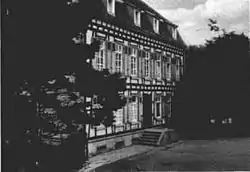 |
Nieder-Ofleiden, Homberg-upon-Ohm 1897-1900 | |
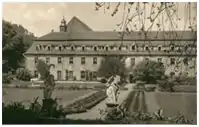 |
Reifenstein, Eichsfeld in Thuringia 1900-1949 |  |
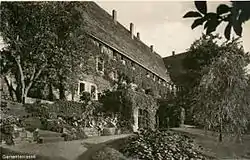 |
Obernkirchen 1901-1971 |  |
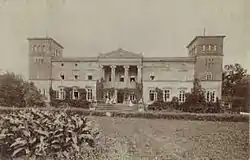 |
Maidburg in the Province of Posen 1904-1919 |  |
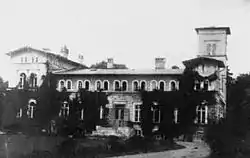 |
Scherpingen in West Prussia 1908-1928 |  |
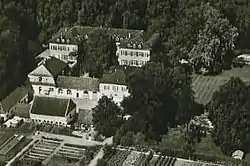 |
Bad Weilbach 1911-1972 |  |
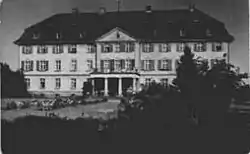 |
Kronprinzessin-Cecilien-Schule Metgethen in Eastern Prussia 1912-1944 |  |
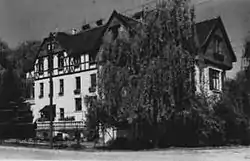 |
Oberzwehren near Kassel 1917-1944 |  |
 |
Chattenbühl (Kattenbühl) near Hannoversch Münden 1918-1964 |  |
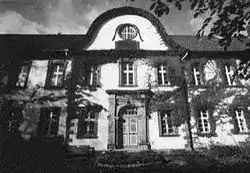 |
Wöltingerode near Goslar 1918-1990 | 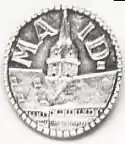 |
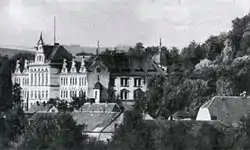 |
Maidhof in Gnadenfrei, Silesia 1919-1945 |  |
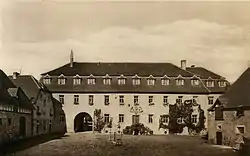 |
Beinrode near Leinefeld in Thuringia 1920-1949 | 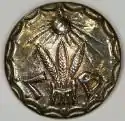 |
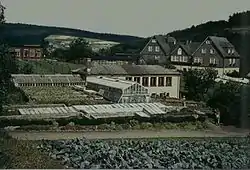 |
Wittgenstein in Sauerland 1928-1990 | |
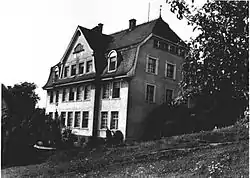 |
Schertlinhaus in Burtenbach 1939-1945 |
Further reading
Historical studies and documents
- Allgemeine Vereinsschrift des Reifensteiner Vereins, Gotha 1915 (advertisement of 1915)
- J. Frick: Wie wird man in Preußen Lehrerin der landwirtschaftlichen Haushaltungskunde? Zweite Auflage 1914 (How to become a female house economics teacher in Prussia)
- Anna von Heydekampf, Maidenstammliste, Gotha : Schmidt & Thelow, 1925 (Members list)
- Ida von Kortzfleisch, Das Maidenbuch 1910 (von Kortzfleischs study book about the Maidens knowledge)
- Johannes Kramer: Das ländlich-hauswirtschaftliche Bildungswesen in Deutschland, Dissertation an der Universität Erlangen, Fulda 1913
- Das Maidenblatt : Organ des Reifensteiner Verbandes für Haus- und Landwirtschaftliche Frauenbildung e. V. und des Maidenbundes, Gotha Schmidt & Thelow 1916–1942
- Preußen Ministerium für Landwirtschaft, Domänen und Forsten: Die Bestimmungen des Herrn Ministers für Landwirtschaft, Domänen und Forsten über die Ausbildung von Lehrerinnen der Landwirtschaftlichen Haushaltungskunde vom 30. März 1914 : Sonderabzug für den Reifensteiner Verein für wirtschaftliche Frauenschulen auf dem Lande, Ministerialblatt für 1914, Berlin Unger (1914 official document about essentials for female teachers in house economics in Prussia)
Publications
- Lotte Matschoss, Die Schneiderpuppe aus Papier, Berlin: Reifensteiner Frauenschulverlag, 1930
- Lotte Matschoss, Farben und ihre Anwendung im täglichen Leben, Reifensteiner Frauenschulverlag, 1930
- Reifensteiner Wäscheregeln Gotha : Schmidt & Thelow, [1930], 7. durchges. u. verm. Aufl.
- Luise Senff, Reifensteiner Grundrezepte für Kochen und Backen, Göttingen : Vandenhoeck u. Ruprecht, 1966, 9. Aufl.
- Elsbeth von Oppen, Reifensteiner Einmachrezepte für Obst und Gemüse, Göttingen : Vandenhoeck & Ruprecht, 1960, Neu bearb. 10. Aufl.
Recent studies
- Ortrud Wörner-Heil: Adelige Frauen als Pionierinnen der Berufsbildung: die ländliche Hauswirtschaft und der Reifensteiner Verband kassel university press GmbH, 2010
- Ortrud Wörner-Heil: Frauenschulen auf dem Lande – Reifensteiner Verband (1897–1997), Schriftenreihe des Archivs der deutschen Frauenbewegung, Band 11, Archiv der Frauenbewegung, 1997
- Anna von Heydekampf (HrsGg.): Ida von Kortzfleisch, ihr Leben und ihr Werk, Gotha, 1927
- Anke Sawahn: Die Frauenlobby vom Land – Die Landfrauenbewegung in Deutschland und ihre Funktionärinnen 1898 bis 1948, DLG-Verlag, 2009
- Juliane Jacobi: Mädchen- und Frauenbildung in Europa – von 1500 bis zur Gegenwart, Campus Verlag, 2013
External links
References
- ↑ Kramer, p. 30–35
- ↑ Kramer, 1913, § 11: Ländlich-hauswirtschaftliche Unterrichtsvorkehrungen im Auslande, p. 110–115
- ↑ Hans Jürgen Teuteberg, «Von der Hausmutter zur Hausfrau. Küchenarbeit im 18./ 19. Jahrhundert in der zeitgenössischen Hauswirtschaftsliteratur», in: Hans Jürgen Teuteberg (Hrsg.) Die Revolution am Esstisch: neue Studien zur Nahrungskultur im 19.-20. Jahrhundert, Franz Steiner Verlag, 2004, u.a. S. 116 -119
- ↑ Britta Oehlke, Wo Hausfrauen gemacht werden...Nordwestdeutsche Haushaltungsschulen und deren Einflüsse und Wirkungen vom ausgehenden 19. bis Mitte des 20. Jahrhunderts. Dortmund: Wulff (2004), Univ., Diss., 2003. Münster (Westfalen),
- ↑ Both titles in Ortrud Wörner-Heil: Adelige Frauen als Pionierinnen der Berufsbildung: die ländliche Hauswirtschaft und der Reifensteiner Verband kassel university press GmbH, 2010, S. 245–246, Wörner-Heil quotes Leixners Titel Zur Frauenfrage in Deutschland 1893, see Tägliche Rundschau from Nr. 220
- ↑ Ortrud Wörner-Heil: Frauenschulen auf dem Lande 1997, S. 26–31
- 1 2 Hans Kratzer: Sauguad. Das Bayerische Kochbuch gibt es seit 100 Jahren. Es spiegelt Küchen- und Technikgeschichte, Sprache und Zeitgeist wider. Und kochen lernt man damit auch., in: Süddeutsche Zeitung, Nr. 244, 23. Oktober 2015, p. R15.
- ↑ Gisa und Bernhard von Barsewisch: Bei den „Edlen Gänsen“ zu Tisch – Vom Kochen und Leben in märkischen Gutshäusern, Ein Zeitbild mit alten Rezepten, Herausgegeben vom Förderverein Schloß-Museum Wolfshagen e. V. L&H Verlag, Berlin, 2. Auflage, ISBN 978-3-939629-08-5
- ↑ "Staatsanzeiger BW: Ruth Steiner (1879 bis 1955)". www.staatsanzeiger.de. Archived from the original on 2016-10-05. Retrieved 2016-08-10.